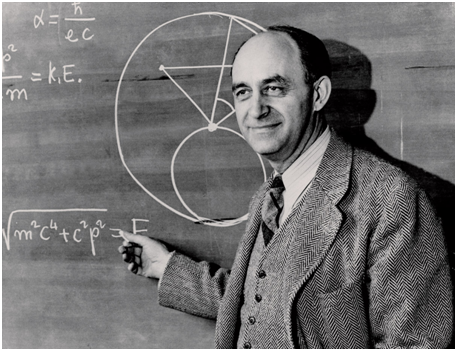In the summer of 1950 President Truman had committed the U.S. to the development of a thermonuclear weapon because the Soviet Union had exploded their first nuclear device the previous summer. Truman wanted a more powerful bomb based on hydrogen fusion. A group of physicists, many of whom had worked on the Manhattan Project, were assembled at Los Alamos National Laboratory. A group of these physicists often met at the Fuller Lodge for lunch.
Enrico Fermi was one of the diners. Fermi had created the world's first nuclear reactor, the Chicago Pile-1. He contributed to quantum theory, particle physics and statistical mechanics. A Nobel Prize winner, Fermi was often referred to as the father of the atomic bomb. During these lunches at the Fuller Lodge, Fermi liked to pose rhetorical questions which he would then proceed to answer, sparking lively discussions.
At one of these lunches, Fermi asked "Don't you wonder where everybody is." This question was asked with respect to extraterrestrials. Fermi proceeded to answer his own question by running through the Drake Equation. The Drake Equation was created by Frank Drake, a SETI researcher, to estimate the possible number technologically advanced alien species in our galaxy. Fermi decided that interstellar travel must be impossible or extremely difficult because otherwise we would have been visited by aliens by now.
Since that conversation, we have learned a great deal more about the factors in the Drake Equation which increases original estimates of the number of possible Earth-like planets in our galaxy. In addition, work on self-replicating machines suggest that even as hard as it appears to be to travel between stars, automated self-replication probes traveling under the speed of light could visit every star in the galaxy within ten million years. Since our galaxy is over thirteen billion years old, that is plenty of time for intelligent races to arise and launch such probes many times. So the Fermi Paradox is even greater today. Where are they?
Some scientists speculate that intelligent technological species have a tendency to destroy themselves before they reach for the stars. This idea is called the Great Filter. If this is true, then the next question is "What is the Great Filter and does it lie before us or behind us on Earth?" Obviously, one of the great extinction threats that faces humanity is nuclear war. Could the development of nuclear weapons be the Great Filter?
Work is already underway to analyze light from planets around other stars to see if it is possible to detect molecules in their atmospheres that might indicate the presence of a technological civilization. Some of those findings could show the destruction of a civilization. The explosion of nuclear bomb generate temperatures that are usually only found in the heart of stars. They also generate great bursts of light. Now some scientists are wondering if a lot of nuclear bombs were set off simultaneously on an alien planet, could the light generated be detected by Earth telescopes. The timing would have to be precise because most theorized destruction signatures would only last for decades at most. How sad and ironic if our first detection of an alien civilization around another star was of its destruction.
So, in answer to Fermi's original question, we might reply that they have not come because they have destroyed themselves with the very type of weapons that you were working on.
Enrico Fermi:
